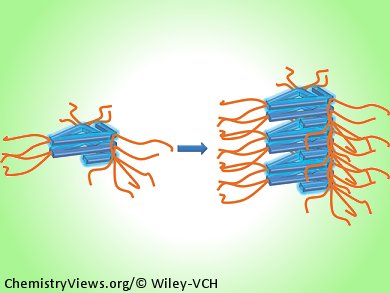Conjugated polymers have found many applications due to their illumination, semiconductive and optoelectronic properties. Solution-processing commonly used for device fabrication, leads to amorphous, disordered molecular arrangements that can impair performance. Self-assembly into supramolecular architectures can lead to organized hierarchical materials with superior properties and has lead to a rapidly developing research area.
Dahui Zhao and colleagues, Peking University, China, prepared conjugated oligo[(ortho-phenyleneethynylene)-alt-(para-phenyleneethynylene)] structures of varied chain length and different side chains.
π-π interactions between phenylene units cause the oligomers to fold: Longer oligomers with nine or more internal phenylene units form helical structures, as evidenced by solvent-dependent electronic absorption and emission spectra. In the folded state, the phenylene rings in the helical structure are confined to nearly coplanar conformations. These are favorable for π conjugation, thus effectively increasing the conjugation length within the molecules.
Oligomers with tri(ethylene glycol) side chains were soluble in water. Examination of their absorption spectra indicates that they form intermolecular aggregates in solvent mixtures with high water contents.
- Helical Folding of Conjugated Oligo(phenyleneethynylene): Chain-Length Dependence, Solvent Effects, and Intermolecular Assembly,
Ningbo Zhu, Qifan Yan, Zhouyang Luo, You Zhai, Dahui Zhao,
Chem. Asian J. 2012.
DOI: 10.1002/asia.201200430




